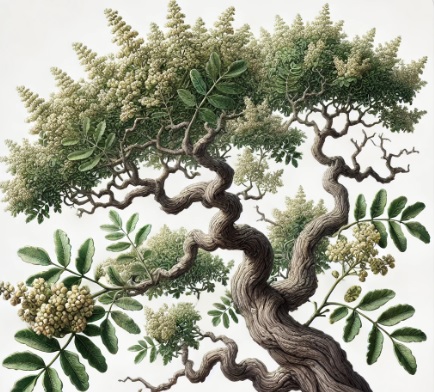Olibanum (Boswellia sacra), commonly known as Frankincense, is a species of Boswellia native to the Arabian Peninsula, particularly the regions of Oman, Yemen, and parts of Somalia. This tree is renowned for its aromatic resin, which has been used for millennia in religious rituals, traditional medicine, and perfumery. The resin, often referred to as frankincense, is harvested from the tree’s bark and is highly valued for its distinctive fragrance and therapeutic properties.
Botanical Classification:
Kingdom: Plantae
Order: Sapindales
Family: Burseraceae
Genus: Boswellia
Species: Boswellia sacra
Plant Characteristics:
Boswellia sacra is characterized by:
Size: A small to medium-sized tree, typically growing to 4-8 meters in height. It has a distinctive appearance with a gnarled, often twisted trunk and a sparse, irregular crown.
Leaves: Pinnate leaves with 10-12 pairs of leaflets that are elliptical to lance-shaped and have a glossy, dark green surface.
Flowers: Small, white or pale yellow flowers arranged in dense clusters. The flowers are not particularly showy but are essential for reproduction.
Resin: The tree produces a resin that is harvested by making incisions in the bark. The resin exudes as a gum-like substance and hardens into aromatic, brittle tears.
Chemical Composition and Structure:
The resin of Boswellia sacra contains a complex blend of compounds, including:
Boswellic Acids: Major active components include beta-boswellic acid, acetyl-11-keto-beta-boswellic acid (AKBA), and alpha-boswellic acid, which are known for their anti-inflammatory and analgesic properties.
Essential Oils: Contains aromatic compounds such as alpha-pinene, limonene, and beta-caryophyllene, contributing to its unique fragrance.
Other Phytochemicals: Includes various terpenes and sesquiterpenes that enhance the resin's therapeutic and aromatic qualities.
Uses and Benefits:
Medicinal: Utilized in traditional medicine for its anti-inflammatory, analgesic, and anti-arthritic properties. Commonly used to relieve symptoms of osteoarthritis, rheumatoid arthritis, and other inflammatory conditions. Some scientific studies support these traditional uses, particularly regarding the anti-inflammatory effects of boswellic acids.
Aromatic: The resin is highly valued in the production of incense and perfumes due to its distinctive, pleasant aroma. It is often used in religious ceremonies, meditation, and as a mood enhancer.
Cosmetic: Extracts are included in skincare products for their soothing and anti-inflammatory properties, benefiting conditions such as acne, eczema, and psoriasis.
Culinary: While not commonly used in modern cuisine, frankincense resin has been historically used as a flavoring agent in certain traditional dishes and beverages.
Applications:
Medicinal: Available in supplements and herbal formulations for its anti-inflammatory and analgesic effects. Often used in capsules, tablets, and topical applications.
Aromatic: Incorporated into incense and perfumes for its aromatic qualities and use in ceremonial contexts.
Cosmetics: Added to skincare products such as creams, lotions, and serums for its anti-inflammatory and soothing effects.
Culinary: Rarely used in contemporary culinary practices but historically employed in some traditional recipes.
Environmental and Safety Considerations:
Environmental Impact: Sustainable harvesting practices are essential to avoid overexploitation of Boswellia sacra. The tree is slow-growing and requires careful management to ensure its conservation.
Safety: Generally considered safe for use, though high doses or prolonged use may cause gastrointestinal discomfort in some individuals. It is advisable to consult a healthcare provider before using Boswellia sacra for medicinal purposes, particularly during pregnancy, breastfeeding, or if there are pre-existing health conditions.
INCI:
Skin protectant. It creates a protective barrier on the skin to defend it from harmful substances, irritants, allergens, pathogens that can cause various inflammatory conditions. These products can also improve the natural skin barrier and in most cases more than one is needed to achieve an effective result.
Skin conditioning agent - Emollient. Emollients have the characteristic of enhancing the skin barrier through a source of exogenous lipids that adhere to the skin, improving barrier properties by filling gaps in intercorneocyte clusters to improve hydration while protecting against inflammation. In practice, they have the ability to create a barrier that prevents transepidermal water loss. Emollients are described as degreasing or refreshing additives that improve the lipid content of the upper layers of the skin by preventing degreasing and drying of the skin. The problem with emollients is that many have a strong lipophilic character and are identified as occlusive ingredients; they are oily and fatty materials that remain on the skin surface and reduce transepidermal water loss. In cosmetics, emollients and moisturisers are often considered synonymous with humectants and occlusives.
Fragrance. It plays a very important role in the formulation of cosmetic products as it provides the possibility of enhancing, masking or adding fragrance to the final product, increasing its marketability. It is able to create a perceptible pleasant odour, masking a bad smell. The consumer always expects to find a pleasant or distinctive scent in a cosmetic product.
Perfuming. Unlike fragrance, which can also contain slightly less pleasant or characteristic odours, the term perfume indicates only very pleasant fragrances. Used for perfumes and aromatic raw materials.
Synonyms:
CAS: 8050-07-5 EC number 232-474-1
![]() Olibanum
Olibanum 
